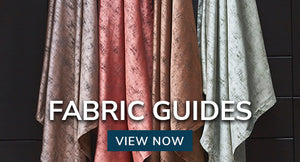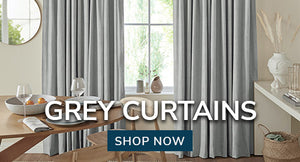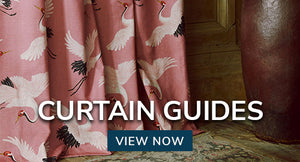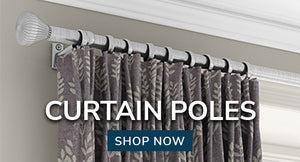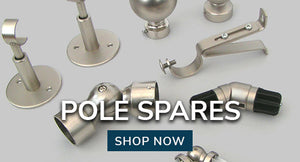Curtain heading type differences: faqs
It’s very easy to look at a pair of curtains and fall in love with their design, especially when looking at the photograph on the packaging or the product images on our website. But, this doesn’t necessary mean they are right for your home. If the window where you want to hang these curtains matches the look, size, dimensions and room type of the window in the photograph then the curtains you are looking at will probably be a perfect match for your home. However, this is very unlikely to be the case.

So to help you to assess which heading type is best for your home, here are four of the most frequently asked questions we get asked about curtain heading type. These four simple questions should help you to determine what heading type is right for your window, and help you avoid any disappoint when they are hung at your window.
What heading type should I choose?
Eyelet - Easy to install, easy to operate, involves little or no dressing as eyelet curtains form columns of fabric which fall into soft pronounced folds. No tapes to draw down. Needs less fullness than gathered headings which can be more cost effective.
Pencil Pleat - Ideal for curtains going beneath pelmets or valances, pencil pleat curtains have a shallow heading and are cost effective. Creates small individual pleats at top of curtain but can be dressed into fuller folds. Ideal on a curtain track in a bay window.
Pinch Pleat - Classic tailored heading style, gives an elegant and sophisticated look, comes ready to hang, little dressing involved to create perfect pleats down the curtain as spacing of folds/pleats are pre-formed by the pinch heading. Can be done with double or triple pinches.
What room types and interior designs work best with each curtain heading type?
Eyelet - Modern, simplistic, fuss-free minimalist look suits any height of ceiling. User friendly. Minimal stack back so excellent for narrow windows or limited wall space, but narrow stack also makes it ideal for very wide windows too.
Pencil Pleat - Ideal for short curtains as standard ready made pencil pleat curtains have a heading that is only 3” deep. Available in 6” deep for longer curtains. Accommodating heading which can be adapted for bespoke or shaped windows such as arched, apex or asymmetrical windows.

Pinch Pleat - Looks best on long curtains as heading is quite deep – usually about 6”. Needs more fullness than most headings so not cost effective or practical for wider windows as needs more fabric and a generous stack back area. Ideal, sympathetic heading for period homes but looks effective in modern interiors too
What fabric and material are best suited to each heading type?
Eyelet - Avoid vertical stripes, large florals or period fabrics such as Renee Mac/Art Deco designs as the pattern can fall irregularly between the folds, giving a distorted look to the design when in the open position. Great for plains and horizontal stripes and most weights of curtain fabric, from voiles to heavy velvets.
Pencil Pleat - Light to medium weight fabrics No limitation on pattern or design choice
Pinch Pleat – Light to medium weight fabrics, not ideal for heavy velvets or very pronounced textures. Pleats are shown off to best effect on plain and smooth finish fabrics. Avoid vertical stripes, large florals or period striped fabrics such as Renee Mac/Art Deco designs as the pattern can fall irregularly between the folds, giving a distorted look to the design when in the open position.
What curtain track or curtain pole should I use with each heading type?
Eyelet - Must be on an eyelet pole, preferably metal for best resistance to wear and tear from the metal eyelet rings. Wooden poles only advisable if curtains are dress curtains only and will not be drawn. Maximum pole diameter recommended for use with eyelets is 30mm. Tie-backs not needed or recommended with this style of heading

Pencil Pleat - Can be hung on any kind of tracks or pole. Recommended for use with tie-backs to keep folds/gathers in place.
Pinch Pleat - Recommended for best use on a curtain pole as not suitable for all types of tracks. Only works on curtain tracks where the curtain can be hung from beneath the track. Not for use with pelmets as the tailored heading will be hidden. Can be used with or without tie-backs.



